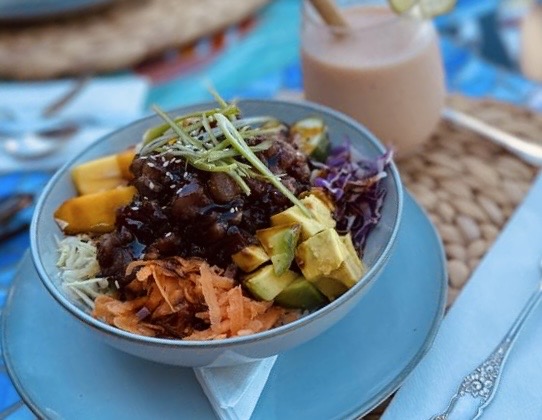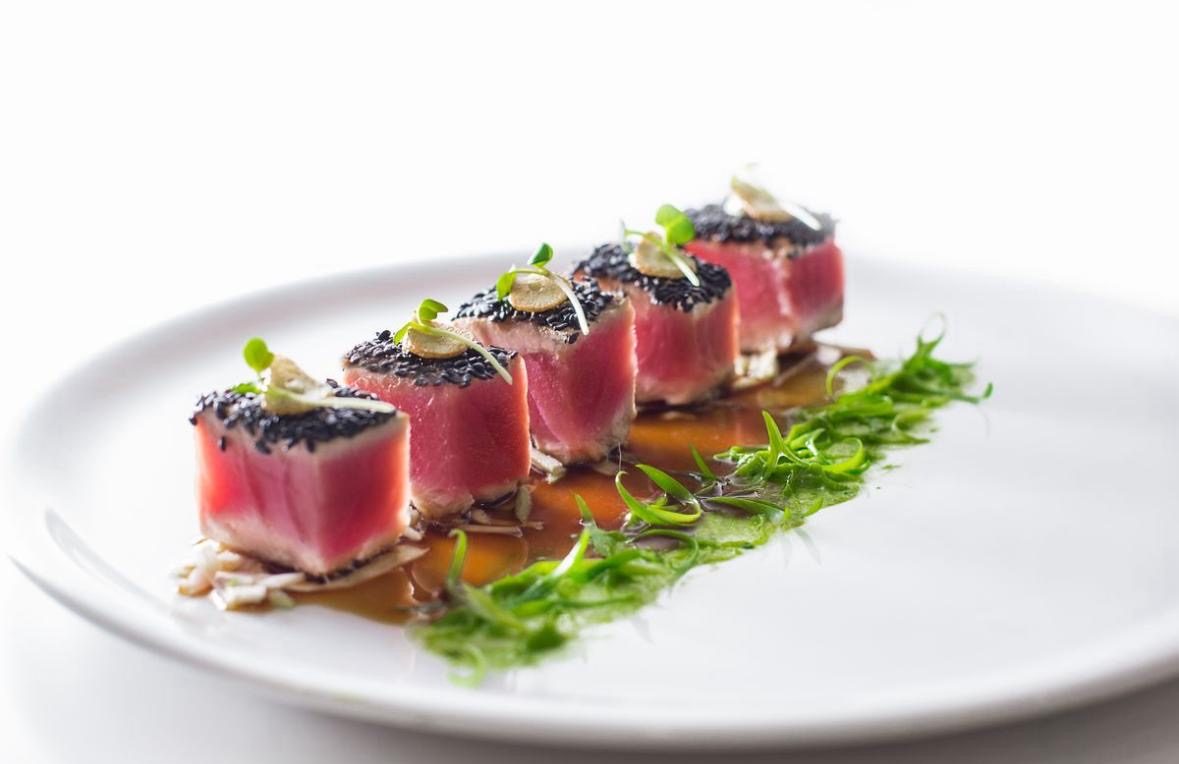Enjoy your freshly caught tuna at home!
Sportfishing for tuna on the Pacific coast of Panama is a very popular activity for all our clients who practice this beautiful sport with us. The waters that surround us are also nicknamed the “Tuna Coast” as it is a famous yellowfin tuna fishing spot, especially between the months of March through July. We made this post for our guests who take home their fresh caught tuna. Perhaps you are looking for a bit of inspiration outside of a regular seared tuna steak. Read more to learn about our freshly caught tuna poke bowls, how to make tuna tataki and how to prepare sashimi tuna.
Tuna is usually enjoyed seared or grilled, but another way to bring its magical flavor is by eating it raw in dishes like “tuna ceviche with avocado and lime”, or the famous “tuna poke bowl”.
Cooked tuna is usually seasoned with salt, pepper, a drizzle of olive oil, and a squeeze of lemon or any other herb like rosemary or thyme, which enhances its fish’s natural flavors. However, the most popular Latin American dish with fresh caught tuna cured in citrus juices is called “ceviche”. This dish is not only refreshing but also packed with flavors that complement the robustness of tuna. Another way to play with raw tuna is by cubing the fish and marinating it over a few hours. A popular marinade consists of soy sauce, sesame oil and ginger. Then it is served over rice with a variety of toppings such as mango, cucumber and scallions. This is the famous “Tuna Poke Bowl” that you can palate at Selva Terra Resort. (picture below).

How to Make Tuna Tataki – One of the main fresh tuna recipes worldwide
The term “tataki” means “hit” or “pounded” in Japanese, when hunters seared the fish quickly over a flame to enhance its flavor and help preserve it for longer. Tuna tataki has since become a culinary Japanese technique. Known for its delightful contrast a lightly seared exterior and a raw, succulent interior texture keeping the inside tender and raw. This dish requires precise execution to ensure the perfect balance of flavors. The right ingredients and careful final touches make this dish a winner here at the resort.
Before starting with the ingredients, it is important to clean the tuna thoroughly with a sharp, long knife and without using water, ensuring that we have a clean cut.
Ingredients
- 1 tablespoon soy sauce
- 1 tablespoon orange juice
- ½ tablespoon lemon juice
- ½ teaspoon mirin
- ¼ teaspoon freshly grated ginger
- 1 ½ tablespoon high smoke point oil, such as peanut oil
- ½ lb sushi-grade yellowfin tuna, ideally in a square or rectangular block
Tuna: Opt for yellowfin tuna, known for its freshness and good quality and cut it in square or rectangular blocks, which helps in achieving even slices
Oil: If you use a high smoke point oil like peanut oil for searing, this will prevent the oil from burning while ensuring a perfect sear without overpowering the tuna’s flavor
Seasoning: You can simply season it with salt, pepper and sesame seeds to enhance the natural flavors of the tuna
The sauce that is typically used in tuna tataki is a ginger ponzu sauce, which is a combination of soy sauce and citrus juice. By adding some mirin and ginger to bring sweetness and a spicy kick, you still get the perfect balance of sharpness of the citrus.
Step By Step – How to Make Fresh Caught Tuna Tataki
- Prepare the Sauce: Combine soy sauce, orange and lemon juice, mirin, and grated ginger in a small bowl. Set aside to let flavors meld
- Prepare the Tuna: Make sure that the tuna is cut into small, square and even pieces to ensure that it will cook uniformly
- Searing the Tuna: Before searing, it is important to dry the fish by patting it to remove excess and avoid oil splatter
- Heat the oil in a skillet over medium-high until it starts to smoke slightly
- Place the tuna in the hot pan and sear for about 30 to 45 seconds on each side. Just enough to create a light char but keeping the interior raw. Be careful not to overdo it, as tuna cooks fast!
- Rest and Slice: After searing, let the tuna rest for a couple of minutes. Then, if you wish the tuna to be tender and melting in your mouth, slice it thinly across the grain using a sharp knife
Arrange the sliced tuna on a platter or individual plates and add the drizzle with the prepared ginger ponzu sauce. Serve with wasabi and add garnish with optional slices of green onions or wakame (seaweed jelly) for an added visual appeal and flavor boost.
Tuna tataki is a very simple way to cook a fresh catch tuna recipe full of flavor, perfect as an appetizer or as part of a light meal. This dish, originally from Japanese cuisine, brings elegance to the table in many restaurants and luxury resorts. It has become one of the most famous fresh catch tuna recipes around the world.

How to Prepare Sashimi Tuna
The term “sahimi” refers to when the fish is caught with a hook and served raw. The culinary embodiments of the definition renders the fish as fresh, sliced and served on its own. Sashimi is another celebrated Japanese delicacy featuring thinly sliced raw fish, prized for its authentic flavor and texture. Here, we will have a deep look at how to prepare fresh catch sashimi tuna, incorporating traditional methods along with a unique twist that includes a spicy, flavorful sauce.
We start with your freshly caught tuna, it should have a bright color, firm texture, and no fishy odor. The perfect sashimi is made with the belly part of the tuna, being the most valued for its rich fat content and smooth, buttery texture. The next step is to clean it thoroughly, without using water, and remove the skin. Using a sharp, long sashimi knife, slice the tuna against the grain. This ensures that the fish’s muscle fibers are cut cleanly, allowing for the most delicate texture possible. A cleanly-cut tuna steak is the hallmark of well-prepared sashimi.
Ingredients
- 2 tablespoons low sodium soy sauce
- 3 teaspoons fresh lemon juice
- 2 1/2 tablespoons Dashi (detailed preparation below)
- 1 1/4 teaspoons Mirin
- 1 teaspoon rice vinegar
- A pinch of Gochugaru (Korean chili flakes) or chili flakes of your choice
- 1 cucumber, thinly sliced
- 3/4 pound sushi-grade yellowfin tuna, thinly sliced
- 1 tablespoon mayonnaise
- Hot sauce, to taste
- 1 teaspoon sesame oil
- Sesame seeds for garnishing
- Sunflower sprouts or any sprouts of your choice
- 1 scallion, thinly sliced
Step By Step – How to Make Fresh Catch Sashimi Tuna
- Prepare the Sauce: Mix the soy sauce, lemon juice, Sashi, Mirin, and rice vinegar together in a large measuring cup. Whisk until it is fully combined and incorporate the gochugaru or chili flakes.
- Spicy Mayo: In a small bowl, blend the mayonnaise, hot sauce, and sesame oil. Keeping blending until smooth, adjusting the heat to your preference
- Plating the Sashimi: arrange the cucumber slices slightly overlapping on a plate
- Plate the thinly sliced tuna atop the cucumbers and drizzle with the prepared sauce from step 1
- Add a dollop of the spicy mayo, then sprinkle with sesame seeds and scallions
- Garnish with sunflower sprouts
You can serve the sashimi tuna immediately, chilled, with additional sauce on the side to accommodate different palates for those who want some extra flavor.

Preparing these special dishes is a fantastic way to experience the culinary traditions of Japan while using the high-quality yellowfin tuna found in Panama. The traditional Japanese culinary background of Japanese cuisine enable us to explore ways to enjoy your fresh catch tuna at home. A gastronomy delight that is both visually appealing and deliciously satisfying.
Be ready to cook something new and let us know how it went! Or book your stay with our Panama Fishing Packages and enjoy these fresh catch tuna recipes at our lodge!




